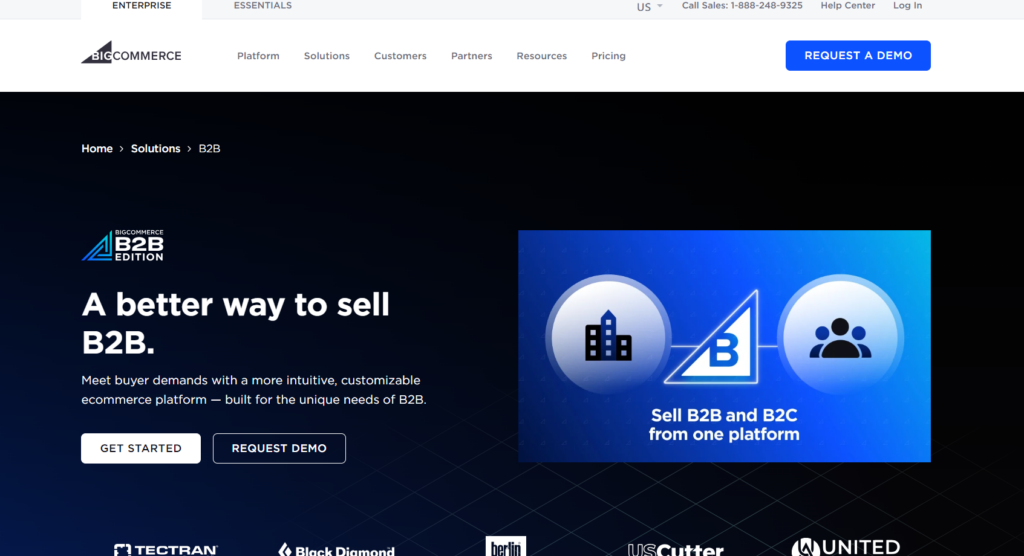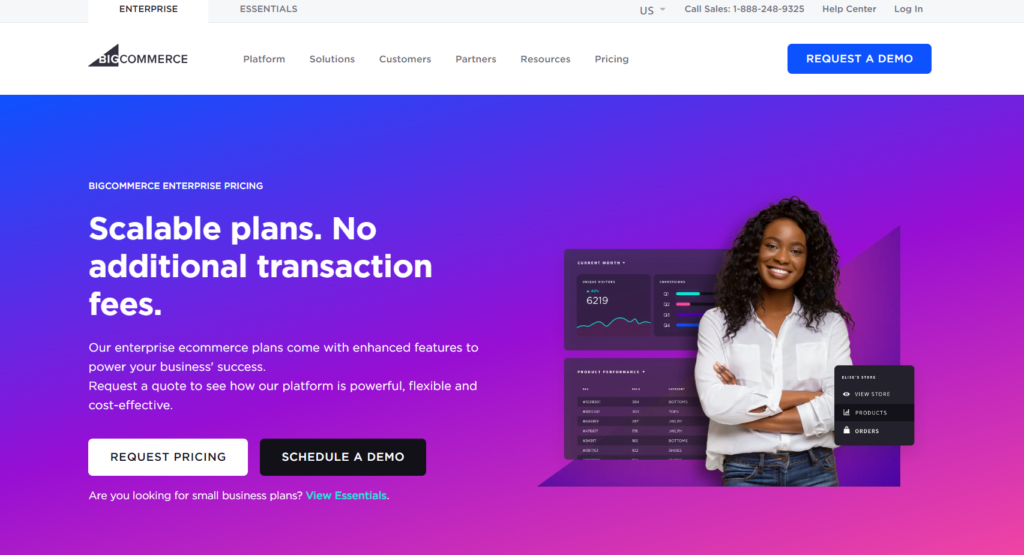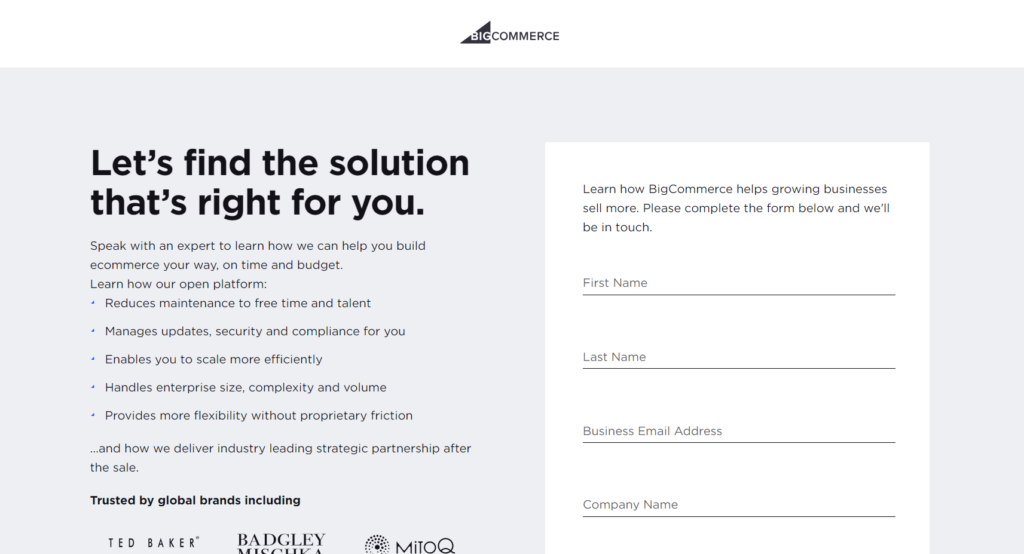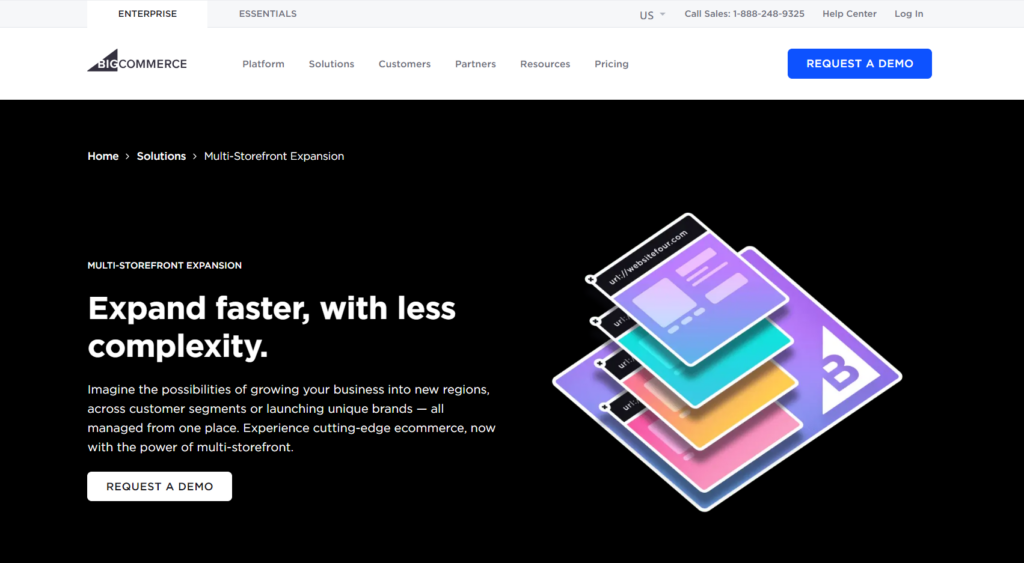Table of Contents
If you want to create or start an online store, you must carefully choose the right platform to build and manage your online store. BigCommerce has become a favored option for businesses of all sizes, offering a strong set of features and scalability. But is it genuinely worth your investment? Read this article till the end to explore BigCommerce’s capabilities, pricing, and possible drawbacks to ensure you make a well-informed decision.
Let's Cut To The Chase!
Buy If:
- You’re looking for a scalable, feature-rich e-commerce platform
- You want a solution that can handle both B2C and B2B sales
- You need strong multi-channel selling capabilities
- You’re seeking a platform with solid SEO features
- You require robust security and reliability
MORE >>> GoDaddy Website Builder Review
Don't Buy It If:
- You’re on a tight budget and need a more affordable solution
- You prefer complete control over your hosting environment
- You’re looking for a simple, no-frills online store
- You need extensive customization without relying on developers
The Bottom Line
🌐 You should explore BigCommerce as a powerful and scalable e-commerce solution, offering a wide range of features that can suit businesses of all sizes. However, pay close attention to its pricing structure and recognize that it may present some limitations in customization, which might not align with your needs. Carefully evaluate your size and budget to determine if BigCommerce is truly the best fit before making any decisions.
Now, Let's Detail Things For You
BigCommerce provides four primary pricing tiers: Standard, Plus, Pro, and Enterprise. Each plan offers an increasing array of features and capabilities designed to meet your needs.
The Standard Plan, priced at $29.95 per month, grants you unlimited products, file storage, and bandwidth. You benefit from no transaction fees and enjoy 24/7 live agent support. Additionally, you gain access to a single-page checkout, real-time shipping quotes, professional reporting tools, and can achieve up to $50,000 in online sales per year.
If you choose the Plus Plan at $79.95 per month, you receive all the features of the Standard Plan, along with an abandoned cart saver, customer groups and segmentation, persistent cart functionality, and the option to store credit cards. This plan allows for up to $180,000 in online sales annually.
The Pro Plan, available for $299.95 per month, includes all the Plus Plan features and adds Google customer reviews, product filtering, and custom product filtering. With this plan, you can reach up to $400,000 in online sales per year.
Finally, the Enterprise Plan offers custom pricing and incorporates all the Pro features, plus additional benefits like price lists, unlimited API calls, custom SSL, priority support, express routing, and strategic account management.
Keep in mind that these prices reflect annual billing. Should you opt for monthly payments, the rates will be slightly higher; for instance, the Standard plan costs $39.95 per month when billed monthly.
What's The Catch With Bigcommerce?

While BigCommerce’s pricing structure appears straightforward, you should be aware of a few potential catches.
One significant concern is the sales volume limits. Each plan includes a maximum annual online sales threshold, and if you exceed this limit, you will automatically be upgraded to the next plan. This can result in unexpected price increases, especially if your business experiences rapid growth.
Even though BigCommerce does not charge transaction fees, you still need to consider payment processing fees from your chosen gateway. These typically range from 2.2% to 2.9%, plus $0.30 per transaction.
While you can find some free themes on BigCommerce, many of the more visually appealing and feature-rich options come with additional costs that can range from $150 to $300 or more.
You’ll also find an app marketplace that offers great flexibility, but keep in mind that some essential functionalities may require paid apps, which can increase your overall costs.
Lastly, if you seek extensive customization beyond what the visual editor allows, hiring a developer may become necessary, significantly raising your investment.
What You Need To Know
To determine whether BigCommerce is worth your investment, dive deeper into the features and benefits it offers.
BigCommerce provides a comprehensive feature set across all plans. You will find unlimited products, file storage, and bandwidth, along with multiple sales channels, including eBay, Amazon, Facebook, and Instagram. The platform also includes a single-page checkout, professional reporting tools, mobile-optimized storefronts, SEO optimization tools, and 24/7 live support. As you explore higher pricing tiers, you will gain access to advanced features such as abandoned cart recovery, customer segmentation, and advanced product filtering.
Consider the scalability of BigCommerce, which stands out as one of its key strengths. This platform can efficiently handle high traffic volumes and large product catalogs, making it an excellent choice for growing businesses. However, keep in mind that this scalability comes with limitations, such as sales volume caps on each plan.
Recognize that BigCommerce excels in multi-channel selling capabilities. You can easily list and sell your products on marketplaces like Amazon and eBay, as well as on social media platforms like Facebook and Instagram, all managed seamlessly from your BigCommerce dashboard.
If you operate in the B2B space, BigCommerce provides specialized features such as customer groups, price lists, and quote management. However, note that these features are primarily available on higher-tier plans.
Evaluate the SEO capabilities that BigCommerce offers, including customizable URLs, automatic sitemaps, and integration with accelerated mobile pages (AMP). These features can significantly enhance your store’s visibility in search engine results.
Ensure you consider the security and reliability aspects of BigCommerce, which boasts an impressive 99.99% uptime and is PCI DSS 3.1 Level 1 certified, ensuring your store and customer data remain secure. The platform also provides automatic backups and updates for added peace of mind.
While BigCommerce features a visual page builder and customizable themes, be aware that extensive customization may require developer expertise, potentially increasing your costs if you seek a highly unique store design.
Finally, take advantage of BigCommerce’s growing app marketplace, which boasts over 1,000 integrations. While this provides you with flexibility, it’s important to acknowledge that some essential functionalities may require paid apps.
PRO TIPS >>> Hostinger vs GoDaddy Web Hosting
What Are Bigcommerce's Competitors Offering?

Now, compare BigCommerce with some of its main competitors:
- Shopify: When considering Shopify, note that its pricing starts at $29 per month for the Basic Shopify plan. Shopify boasts a larger app ecosystem, while BigCommerce includes more built-in features. Remember that Shopify charges transaction fees unless you use Shopify Payments, whereas BigCommerce offers more robust B2B features.
- WooCommerce: Now, look at WooCommerce, which is a free plugin. However, you will pay for hosting and potential extensions. WooCommerce gives you more control and customization options, but BigCommerce provides better built-in features and support. Be aware that WooCommerce requires more technical knowledge to set up and maintain.
- Magento ( Now Adobe Commerce): As for Magento (Adobe Commerce), its pricing is not disclosed. Magento offers more customization possibilities, yet BigCommerce is easier to use and requires less technical expertise. Magento is typically more suitable for large enterprises.
- Wix: Its e-commerce plans start at $17 per month. Wix is more user-friendly for beginners, but BigCommerce delivers more advanced e-commerce features. While Wix provides better design flexibility for non-technical users, BigCommerce excels in functionality.
What Affects Bigcommerce's Prices?

Several factors influence BigCommerce’s pricing structure:
- Assess Your Feature Set: Understand that the more advanced features you require, the higher the plan you’ll need. This is why prices increase significantly between tiers. Investigate each plan to ensure it aligns with your business requirements and future aspirations.
- Evaluate Your Sales Volume: Acknowledge that BigCommerce’s unique pricing model ties costs directly to your annual sales volume. As your business expands and sales increase, prepare to upgrade to more expensive plans. Monitor your sales growth to anticipate when an upgrade will be necessary.
- Understand Integration Costs: Explore the numerous integrations BigCommerce offers, but be aware that some may incur additional costs. These integration expenses can impact your overall budget, so assess which integrations are essential for your operations and factor them into your pricing strategy.
- Factor in Development and Customization: If you require extensive customization, prepare to account for potential developer costs. These costs can significantly impact your total investment. Outline your customization needs early on and obtain estimates from developers to ensure you budget accurately for these additional expenses.
- Consider Seasonal Trends: Recognize that your business may experience seasonal fluctuations in sales. Be proactive in adjusting your plan according to these trends, as your pricing may need to adapt to the ebb and flow of your business activity.
- Account for Additional Fees: Investigate any additional fees that may apply, such as transaction fees or payment processing costs. These can vary based on the plan you choose and may affect your overall pricing structure, so review these details carefully before committing.
What Affects Prices In The E-commerce Platform Industry Overall?
Several factors influence pricing across the e-commerce platform industry:
- Analyze Market Competition: As more players enter the market, pricing strategies evolve to remain competitive. Observe how new entrants and established platforms adjust their pricing to attract customers. This competition can lead to better features and lower prices, so keep an eye on market dynamics to ensure you’re getting the best value.
- Evaluate Technological Advancements: Recognize that new features and capabilities often lead to price adjustments as platforms invest in development. The introduction of innovative tools, such as enhanced analytics or automated marketing features, can provide significant value but may also increase subscription costs. Stay informed about technological trends to maximize the benefits of these advancements.
- Understand Hosting Costs: Consider that the cost of maintaining a robust and secure hosting infrastructure directly impacts platform pricing. E-commerce platforms invest heavily in reliable hosting to ensure optimal performance and security. As these costs rise, platforms may adjust their prices, so understanding this factor can help you evaluate your options more effectively.
- Consider Support Services: Acknowledge that the level and quality of customer support provided can significantly influence pricing. Platforms that offer premium support services often charge higher fees, but this can save you time and resources when facing challenges. Evaluate your business needs to determine the appropriate level of support for your operations.
- Review Integration Capabilities: Investigate how the ability to integrate with various third-party services and tools affects pricing structures. Enhanced integration options can streamline your business processes, but they may also lead to additional costs. Assess which integrations are crucial for your success and incorporate these considerations into your budget planning.
- Monitor Economic Factors: Stay aware of broader economic trends that may influence pricing in the e-commerce platform industry, such as inflation and shifts in consumer spending habits. These factors can prompt platforms to adjust their pricing strategies, making it essential to remain informed about the economic landscape and its potential impact on your costs.
- Analyze User Demand: Recognize that user demand for specific features or functionalities can drive pricing adjustments across the industry. As businesses increasingly seek particular capabilities, platforms may raise their prices to reflect this demand. Keep track of industry trends to ensure you remain competitive and avoid unexpected price hikes.
- Review Subscription Models: Understand that various subscription models exist within the e-commerce platform industry, each with different pricing structures. As your business evolves, regularly assess whether your current model aligns with your goals and budget. Explore alternatives that may offer better value as your needs change.
- Evaluate Regulatory Compliance: Be aware that compliance with regulations and data protection laws can also impact pricing. E-commerce platforms may incur additional costs to meet these legal requirements, which can be reflected in their pricing models. Stay informed about relevant regulations to anticipate how they may affect your chosen platform’s costs.
GET SMARTER >>> Atlantic.net Hosting Service: Buy or Not?
How To Get The Best Deal With Bigcommerce?

To maximize your value when using BigCommerce:
- Choose the Right Plan: Assess your needs and projected sales carefully. Select the plan that best fits you, and avoid overpaying for features you won’t use.
- Opt for Annual Billing: If you feel confident in your plan choice, choose annual billing. This decision can save you money on monthly costs.
- Leverage Free Themes and Apps: Start with free themes and apps before investing in paid options. This approach helps keep your initial costs down.
- Utilize Built-in Features: Make the most of BigCommerce’s built-in features before exploring paid apps for additional functionality.
- Take Advantage of the Free Trial: Use BigCommerce’s 15-day free trial to thoroughly test the platform. This trial helps you assess if it’s the right fit for you before making a commitment.
- Negotiate Enterprise Rates: If you run a large business, don’t hesitate to negotiate custom rates for the Enterprise plan. This can lead to significant savings tailored to your needs.
Can You Afford Bigcommerce's Prices?
Determining if you can afford BigCommerce depends on several factors:
Have you considered your business size when selecting a plan, such as whether the Standard plan at $29.95/month is manageable for a small startup? Can your profit margins absorb the platform costs while still allowing for a healthy profit?
Have you factored in your growth projections, particularly if you expect rapid expansion that may require budgeting for higher-tier plans in the future? If you lack in-house technical expertise, have you accounted for potential developer costs for necessary customization? Finally, have you assessed which features are essential for your business and whether those needs warrant a higher-tier plan?
Finally: Should You Buy Bigcommerce Or Not?
After careful consideration of BigCommerce’s features, pricing structure, and overall value proposition, you should buy BigCommerce.
BigCommerce provides a robust and scalable solution ideal for ambitious e-commerce businesses, featuring strong multi-channel capabilities and built-in B2B functionalities. While it may not be the cheapest option, its reliability, security, and extensive native features justify the investment, helping you save money in the long run by reducing the need for additional paid add-ons.
Despite some potential downsides, such as sales volume limits and the need for developer assistance for customization, the platform’s strengths, including its SEO tools and ability to manage high traffic and large product catalogs, make it a strong choice for scaling your e-commerce operations.








